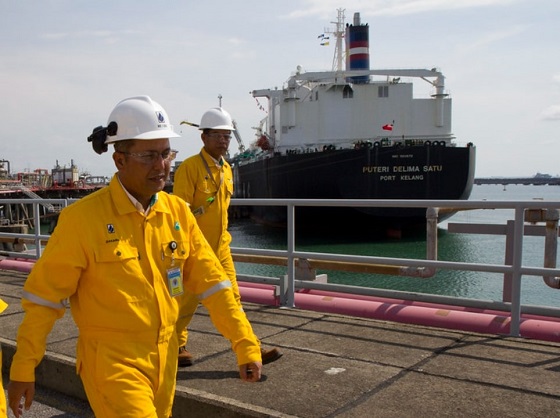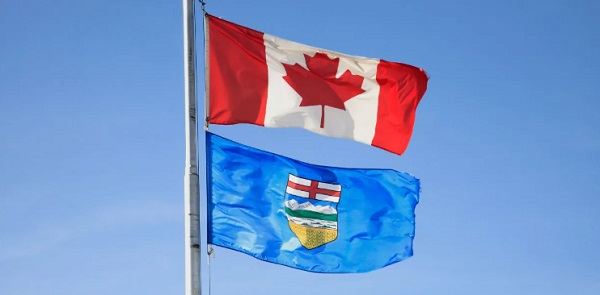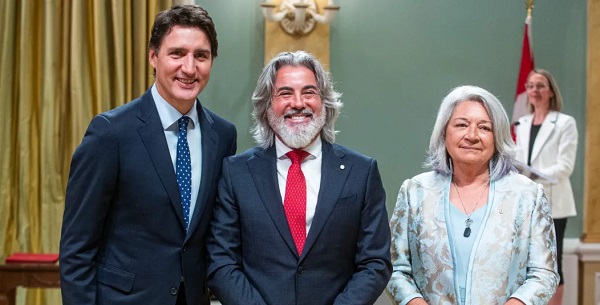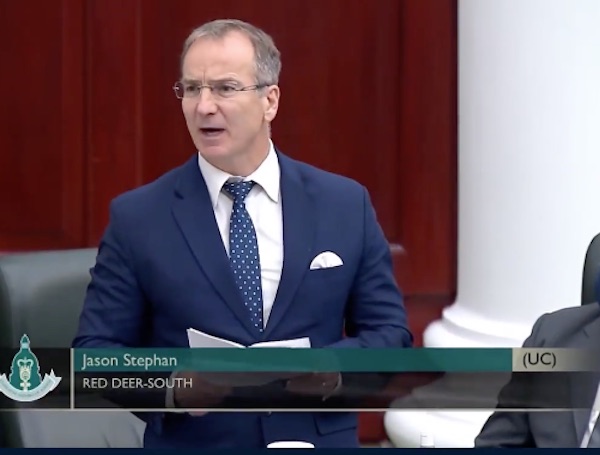Economy
Newly discovered business case for Canadian energy could unleash economic boom

From Resource Works
Canada has a hefty slate in recent years of big natural-resource projects that were abandoned, or put on a back burner, often because of government action or inaction.
One estimate is that Canada has seen $670 billion in cancelled resource projects since 2015, when Justin Trudeau became prime minister.
True, the Trudeau government in 2018 backed and took over the Trans Mountain oil pipeline expansion project, known as TMX. That’s been a success since May 2024, moving oil to U.S. and Asian buyers. It’s looking now to move more oil to Asia. And Ottawa is talking of First Nations getting some equity interest in it.
Many other major projects have been shelved or scrapped, though, some due to corporate economic decisions, but many due to governments.
One prime example was the Énergie Saguenay LNG project in Quebec. That $20-billion plan was fatally throttled in 2022 — on green grounds — by Quebec’s government and Trudeau’s minister of environment and climate change, Steven Guilbeault.
Now, with Trudeau leaving and a potential change federal government possible, there’s some early talk of reviving some projects. For example, Nova Scotia Premier Tim Houston has urged Ottawa to “immediately” revive the Energy East oil pipeline project.
And U.S. President Donald Trump’s threats of tariffs on imports from Canada have underlined calls for new energy exports to new overseas customers.
We list below 31 projects that have been abandoned or shelved, or have not been heard from for years. They are listed in order of the year of cancellation, or the year they were last heard from.
Keltic LNG
This project was actually an LNG import facility that would then manufacture plastic pellets. It won its first government approval (from Nova Scotia) in 2007. But it never went ahead, and all approvals long ago expired.
Corridor Resources shale gas
Proposed in 2011, the idea was to produce from the huge shale-gas reserves in New Brunswick. But Corridor Resources (now called Headwater Exploration Inc) was unable to find a partner. And in 2014 the N.B. government put a moratorium on hydraulic fracturing (“fracking”) for gas; it is still in effect.
Dunkirk oil sands
Proposed by the billionaire Koch brothers of the U.S. in 2014, but ditched later that year, this Alberta project was supposed to produce up to 60,000 barrels a day, using the in-situ steam-assisted gravity drainage (SAGD) process.
Kitsault LNG
Kitsault Energy proposed in 2013 an LNG-for-export project at the northern mining ghost town of Kitsault BC. It hoped to line up a pipeline partner, create an ‘energy corridor’, and to begin production in 2018. It said it was still working on cost estimates in 2014, and nothing was heard thereafter.
Carmon Creek oil sands
Shell proposed this in 2013, to produce 80,000 barrels a day. The company in 2014 said it would slow down the project while attempting to lower costs and improve its design. But in 2015, Shell gave up on it, giving a lack of pipelines to coastal waters as one reason.
Stewart LNG
The Canada Stewart Energy Group proposed in 2014 an LNG terminal near Stewart in northern BC. It aimed to produce 30 million tonnes a year, starting in 2017. It has not been heard from since 2014.
Watson Island LNG
This LNG terminal was proposed in 2014 by Watson Island LNG Corporation, to be located at Prince Rupert, with capacity to produce one million tonnes of LNG a year. There have been no updates since 2014, and the project’s website is no longer online.
Discovery LNG
Rockyview Resources was the developer of this LNG project at Campbell River on Vancouver Island, first proposed in 2014. It was a big plan, for 20 million tonnes of LNG a year, and would need a 300-km pipeline from the mainland. As of January 2018, Rockyview was reported still seeking partners, but there have been no updates since 2015.
Orca LNG
A Texas-based company got from Canada’s National Energy Board in 2015 a license to export 24 million tonnes of LNG a year, from a proposed plant at or near Prince Rupert. There has been no news from the developer since then.
New Times Energy LNG
New Times Energy proposed in 2015 to locate at Prince Rupert an LNG terminal capable of producing 12 million tonnes of LNG a year. Ottawa approved its export licence in 2016, but there has been no news of the project, or of any pipeline to feed it, since then.
Northern Gateway
Journalist Tom Fletcher recently looked in Northern Beat at the idea of reviving the $7.9-billion Northern Gateway pipeline, first proposed in 2008 and shelved in 2016.
“One new project that could be reactivated is the Northern Gateway oil pipeline, snuffed out by Prime Minister Justin Trudeau’s environmental posturing.
“Already burdened by court challenges, Enbridge’s Northern Gateway was killed by Trudeau’s 2016 declaration that oil tankers shouldn’t be allowed near the ‘Great Bear Rainforest.’
“He is among many urban people who are unaware this faux-Indigenous name was dreamed up by professional environmentalists at a fancy restaurant in San Francisco, explicitly to create a barrier for Canadian oil exports to Asia. . . ..
“Those Asia exports have finally begun to flow in significant volumes through the recent Trans Mountain pipeline expansion, which has been mostly at capacity since it opened.”
Fletcher notes that in 2021 then-Conservative leader Erin O’Toole campaigned on a promise to revive the Northern Gateway pipeline.
“Whether a new federal government can or wants to revive Northern Gateway is unknown. But combined with Coastal Gaslink, it would build on a northern resource corridor that could also include the already-permitted Prince Rupert Gas Transmission line now proposed by TC Energy and the Nisga’a government.
“The Prince Rupert line would supply a floating LNG plant (the Nisga’a Nation’s Ksi Lisims LNG project) and new power lines along the energy corridor could help serve the needs of the broad expanse of northern B.C. that remains off the grid.”
Muskwa oil sands
Another project of the Koch brothers in Alberta’s oil sands, proposed in 2012, this project was to produce 10,000 barrels per day. It was scrapped in 2016, with the developer citing “regulatory uncertainty.”
Douglas Channel LNG
This modest (0.55 million tonnes a year) floating LNG project was led by Alta Gas. The plan was for a $400-million floating terminal in Douglas Channel near Kitimat. It was shelved in 2016, with Alta Gas citing a global surplus in LNG, and low prices.
Triton LNG
At the same time as scrapping Douglas Channel LNG (above), Alta Gas and partner Idemitsu Kosan of Japan put a freeze on the Triton LNG project in the same area. It was proposed in 2013, and was to have produced up to 2.3 million tonnes of LNG per year.
Energy East
Another classic and costly example of shelving was the $15.7-billion Energy East pipeline. This was proposed in 2013, the aim being to switch 3,000 km of the TransCanada gas pipeline to carry oil, and add another 1,500 km of oil pipeline and facilities. All this so it could move oil from Alberta and Saskatchewan to Quebec and New Brunswick refineries, for domestic use and for exports.
The project was strenuously attacked by environmental groups (and a number of First Nations) and a poll showed nearly 60% of Quebecers opposed it. Quebec politicians called for more stringent environmental rules to apply to it, and the Quebec government decided on a court challenge, to ensure the Quebec portion of the project met that province’s environmental laws and regulations.
Trans Canada (now TC Energy) then shelved the project in October 2017, citing “existing and likely future delays resulting from the regulatory process, the associated cost implications and the increasingly challenging issues and obstacles.” The project had already cost Trans Canada $1 billion.
(The same day, Trans Canada also scrapped its Eastern Mainline project, to add new gas pipeline and compression facilities to the existing system in Southern Ontario.)
New Brunswick Premier Blaine Higgs soon sought to revive Energy East, and discussed it with Trudeau. He quoted Trudeau as saying he’d be willing to discuss the issue again if Higgs was able to get Quebec onside. But Trans Canada repeated its announced decision.
Now, with Trump threatening tariffs, Nova Scotia Premier Tim Houston is calling on Ottawa to approve the Energy East oil pipeline. He said Trump’s tariffs mean here is “urgency” to strengthen the country through projects such as Energy East.
Earlier, commentator Brian Zinchuk of Pipeline Online urged: “If (Conservative leader Pierre) Poilievre wins a massive majority, can we PLEASE build the Energy East Pipeline?”
Zinchuk added: “So what could a newly empowered government with a massive majority do? Here’s a novel idea: Call up TC Energy and ask them to dust off their 2014 application to build the Energy East Pipeline. We’re going to need it.”
Mackenzie Valley Pipeline
This project was first proposed in the early 1970s to move natural gas from the Beaufort Sea to northern Alberta, and then to tie in to existing gas pipelines there.
Ottawa launched in 1974 a federal inquiry into the project. After three years (and at a cost of $5.3-million) inquiry commissioner Thomas Berger said in 1977 that the 1,220-km pipeline should be postponed for 10 years, estimating that it would take that long for land claims to be settled and for Indigenous Peoples to be ready for the impact of such a project.
Eventually, after another six years of review, the Mackenzie Valley pipeline was granted federal approval in 2011, subject to 264 conditions.
But by 2017 the initially estimated costs of $8 billion had risen to $16.2 billion, and the joint-venture partnership of Imperial Oil, ConocoPhillips Canada, ExxonMobil Canada and the Aboriginal Pipeline Group announced abandonment of the project, citing natural gas prices – but also the long regulatory process.
Said an Imperial Oil official: “Our initial estimate for the timing for the regulatory process was somewhere between 22 and 24 months. We filed for regulatory approval in October 2004 and we received final regulatory approval in 2011. I’ll leave it up to you to decide if that is a reasonable amount of time for a significant capital investment project.”
Prince Rupert LNG
Shell Canada took over in 2016 the BG Group’s back-burnered 2012 proposal for an $11-billion LNG terminal on Ridley Island, Prince Rupert. It was to produce 21 million tonnes of LNG per year. But in 2017, Shell shelved the project.
That also killed the $9.6-billion Westcoast Connector pipeline proposed by Enbridge in 2012. This was to build an 850-km natural gas pipeline corridor from northeast B.C. to Ridley Island to feed gas to Prince Rupert LNG.
There followed recently some thought that this Westcoast Connector pipeline could be revived, to feed the Nisga’a Nation’s proposed Ksi Lisims LNG project, but Ksi Lisims chose to take over the Prince Rupert Gas Transmission pipeline (PRGT).
Pacific Northwest LNG
Pacific NorthWest LNG proposed in 2013 a $36-billion LNG-for-export plant on Lelu Island south of Prince Rupert BC.
It was to produce up to 20.5 million tonnes of LNG a year, and would include a marine terminal for loading LNG on to vessels for export to markets in Asia.
As ever, the proposal ran into opposition from environmental and some (but not all) Indigenous groups. And in 2017, Malaysia’s Petronas and its minority partners (China’s Sinopec, Japan’s JAPEX, Indian Oil Corporation and PetroleumBrunei) decided not to proceed.
They cited “changes in market conditions.” But CEO Mike Rose of Tourmaline Oil, Canada’s largest natural-gas producer, pointed a finger at governments, saying “government dithering” played a role in the cancellation.
“They [Petronas] kept getting held up. . . . All levels of government were trying to squeeze more money out of them.”
Rose said a “more effective, streamlined approval process,” would have seen Petronas make a final investment decision on the project three years earlier, when LNG prices were much higher.
(Petronas continues to be a 25% partner in the LNG Canada project, which goes online later this year.)
The Pacific NorthWest LNG plant would have been fed by TC Energy’s 900-km Prince Rupert Gas Transmission pipeline (PRGT). The permits for that line now are owned by the Nisg̱a’a First Nation and partner Western LNG. They propose a route change so the line can feed the Nation’s planned Ksi Lisims LNG plant. The B.C. Environmental Assessment Office now is considering whether the pipeline’s permits are still valid.
Aurora LNG
Nexen Energy, with Chinese and Japanese partners, proposed in 2014 the $28-billion Aurora LNG terminal on Digby Island, Prince Rupert. It would have produced up to 24 million tonnes of LNG a year. The partners ditched the plan in 2017, citing the economics.
WCC LNG
Exxon Mobil and Calgary-based Imperial Oil proposed in 2015 this $25-billion LNG export facility on Tuck Inlet, Prince Rupert. It was to produce some 30 million tonnes per year. The partners scrapped the project in 2018, without explanation.
Grassy Point LNG
Australia’s Woodside Energy proposed in 2014 a $10-billion facility 30 km north of Prince Rupert, to produce up to 20 million tonnes of LNG per year. Woodside shelved the plan in 2018. It said it would focus instead on the Kitimat LNG project with Chevron Canada (but that also died on the drawing board. (See ‘Kitimat LNG’ farther below)
Aspen oil sands
An Imperial Oil project, proposed in 2013, was to produce up to 150,000 barrels of bitumen a day. The $7-billion project was put on hold in 2019.
Kwispaa LNG
Proposed in 2014, this was an $18-billion project for an LNG plant near Bamfield on Vancouver Island, with an associated natural-gas pipeline. It was to be developed by Steelhead LNG Corporation through a co-management partnership with the Huu-ay-aht First Nations. The plan was to produce 12 million tonnes a year, and later up to 24 million. Steelhead stopped work on it in 2019, and in 2022 Ottawa formally terminated the environmental-assessment window for the project.
Frontier Oil Sands
Teck proposed this $20.6-billion mining project in Alberta’s oil sands in 2012, but gave up the idea in 2020. It would have had production capacity of about 260,000 barrels a day.
Kitimat LNG
Kitimat LNG was a $30-billion LNG-for-export plant at Kitimat BC, proposed in 2018 by Chevron Canada and Australia’s Woodside Energy. It was designed to produce up to 10 million tonnes of LNG a year.
Chevron sought to sell its share of the project but failed to find a buyer, and in the end Chevron and Woodside shelved the project in 2021.
Kitimat LNG would have been fed gas bv the proposed Pacific Trails Pipeline, a project by Chevron and Apache Corporation. Woodside Australia had bought Apache’s stake in the project for $2.75 billion in 2014. The pipeline plan has also been put away.
Goldboro LNG
Alberta energy company Pieridae proposed in 2011 an LNG plant on Nova Scotia’s east shore. The plan was to ship 10 million tonnes per year to Europe. But the project failed to win $925 million in federal funding, and Pieridae bailed out in 2021
Keystone XL
The $8-billion Keystone XL pipeline was proposed in 2008 by TC Energy, to deliver Alberta oil to Nebraska, and then, through existing pipelines, to refineries on the U.S. Gulf Coast.
The project got its key U.S. presidential permit from then-president Donald Trump in 2017. Work eventually began in 2020, with the Alberta government kicking in $1.5 billion, and a promise of a $6-billion loan guarantee, in hopes of completion in 2023.
But under pressure from environmental groups, U.S. president Joe Biden revoked the permit on his first day in office on January 20, 2021, citing the “climate crisis.”
So this was, then, a rare Canadian project cancellation engineered by the U.S., not by Canada.
Énergie Saguenay
In 2015 came GNL Québec’s $20-billion proposal to build an LNG plant at the port of Saguenay in Quebec.
The Énergie Saguenay project, backed by Ruby Capital of the U.S., would connect to TC Energy’s Canadian Mainline, the big natural gas pipeline that carries gas from Western Canada to markets in Canada and the United States. The connection would be via a 780-km pipeline from northeastern Ontario to Saguenay, proposed by Gazoduq Inc.
Énergie Saguenay said its plant would produce 10.5 million tonnes of LNG a year. (The LNG Canada plant in B.C. will produce up to 14 million tonnes a year.) Énergie Saguenay said it would export its LNG via the St. Lawrence and Saguenay Rivers. It spoke of 140-165 shipments per year
The project raised considerable interest, as Germany, Latvia and Ukraine were expressing interest in importing Canadian LNG. Germany’s Chancellor Olaf Scholz came to Canada in the summer of 2022 and asked Trudeau about LNG exports.
Trudeau, though, said he saw no business case for LNG exports to Europe, and said Canada could always send natural gas to the U.S., where Americans could turn it into American LNG and send that to Europe. (This was already happening, and continues.)
In the end, the Quebec government, which initially supported Énergie Saguenay, changed its mind and pulled the plug on environmental grounds.
Then Steven Guilbeault, federal minister of environment and climate change, hammered home the final coffin nail in 2022, saying: “The Énergie Saguenay Project underwent a rigorous review that clearly demonstrates that the negative effects the project would have on the environment are in no way justifiable.”
That regulatory rejection has led to a $20.12-billion international damage claim against the federal government by Ruby Capital.
Bear Head LNG
Bear Head Energy planned in 2014 to build an LNG-for-export plant on the Strait of Canso, Nova Scotia. It was to send 12 million tonnes a year to Europe. But in 2023 Bear Head, under new ownership, announced plans instead to produce hydrogen for export.
Port Edward LNG
Planning started in 2019 for this $450-million small-scale LNG project, for a site east of Port Edward BC. It was to ship LNG overseas in containers, but the project was scrapped in 2024.
Enbridge Line 5
Under appeal is a U.S. court order to shut down, by 2026, this pipeline that carries Canadian oil to Ontario, by way of Wisconsin and Michigan. In the court case, the Wisconsin-based Bad River Band, through whose territory the pipeline runs, seeks to have it shut down.
A U.S. district court ordered Enbridge in 2023 to shut down parts of the pipeline within three years and pay the band $5.2 million for trespassing on its land. Enbridge is appealing (and so is the Bad River Band, which wants an immediate shutdown.)
What’s next?
While there has been a little chatter about reviving some of the scratched projects, there have been no formal proposals for resurrections, and Canada’s current attention is on Donald Trump and his promised tariffs in imports from Canada
On the political front in Canada, national Conservative leader Pierre Poilievre said in a recent speech in Vancouver: “By blocking pipelines and LNG plants in Canada, the Liberals have forced Canadians to sell almost all of our energy to the United States, giving President Trump massive leverage in making these tariff threats.”.
He said that that if he was prime minister, he would have approved pipelines such as Northern Gateway and Energy East, as well as giving fast-track approvals for LNG plants, thus giving Canada more export options.
And Poilievre promised to allow pipeline companies on First Nations lands to pay some of their federal tax to affected nations.
“Then these communities will have a very powerful incentive to say yes, and they can use some of that money to defeat poverty, build schools and hospitals and clean water and other essentials for their people.”
But now Canada has first to cope with Trump’s Fortress America economic-warfare plans.
Alberta
Carney forces Alberta to pay a steep price for the West Coast Pipeline MOU

From the Fraser Institute
The stiffer carbon tax will make Alberta’s oil sector more expensive and thus less competitive at a time when many analysts expect a surge in oil production. The costs of mandated carbon capture will similarly increase costs in the oilsands and make the province less cost competitive.
As we enter the final days of 2025, a “deal” has been struck between Carney government and the Alberta government over the province’s ability to produce and interprovincially transport its massive oil reserves (the world’s 4th-largest). The agreement is a step forward and likely a net positive for Alberta and its citizens. However, it’s not a second- or even third-best option, but rather a fourth-best option.
The agreement is deeply rooted in the development of a particular technology—the Pathways carbon capture, utilization and storage (CCUS) project, in exchange for relief from the counterproductive regulations and rules put in place by the Trudeau government. That relief, however, is attached to a requirement that Alberta commit to significant spending and support for Ottawa’s activist industrial policies. Also, on the critical issue of a new pipeline from Alberta to British Columbia’s coast, there are commitments but nothing approaching a guarantee.
Specifically, the agreement—or Memorandum of Understanding (MOU)—between the two parties gives Alberta exemptions from certain federal environmental laws and offers the prospect of a potential pathway to a new oil pipeline to the B.C. coast. The federal cap on greenhouse gas (GHG) emissions from the oil and gas sector will not be instituted; Alberta will be exempt from the federal “Clean Electricity Regulations”; a path to a million-barrel-per day pipeline to the BC coast for export to Asia will be facilitated and established as a priority of both governments, and the B.C. tanker ban may be adjusted to allow for limited oil transportation. Alberta’s energy sector will also likely gain some relief from the “greenwashing” speech controls emplaced by the Trudeau government.
In exchange, Alberta has agreed to implement a stricter (higher) industrial carbon-pricing regime; contribute to new infrastructure for electricity transmission to both B.C. and Saskatchewan; support through tax measures the building of a massive “sovereign” data centre; significantly increase collaboration and profit-sharing with Alberta’s Indigenous peoples; and support the massive multibillion-dollar Pathways project. Underpinning the entire MOU is an explicit agreement by Alberta with the federal government’s “net-zero 2050” GHG emissions agenda.
The MOU is probably good for Alberta and Canada’s oil industry. However, Alberta’s oil sector will be required to go to significantly greater—and much more expensive—lengths than it has in the past to meet the MOU’s conditions so Ottawa supports a west coast pipeline.
The stiffer carbon tax will make Alberta’s oil sector more expensive and thus less competitive at a time when many analysts expect a surge in oil production. The costs of mandated carbon capture will similarly increase costs in the oilsands and make the province less cost competitive. There’s additional complexity with respect to carbon capture since it’s very feasibility at the scale and time-frame stipulated in the MOU is questionable, as the historical experience with carbon capture, utilization and storage for storing GHG gases sustainably has not been promising.
These additional costs and requirements are why the agreement is the not the best possible solution. The ideal would have been for the federal government to genuinely review existing laws and regulations on a cost-benefit basis to help achieve its goal to become an “energy superpower.” If that had been done, the government would have eliminated a host of Trudeau-era regulations and laws, or at least massively overhauled them.
Instead, the Carney government, and now with the Alberta government, has chosen workarounds and special exemptions to the laws and regulations that still apply to everyone else.
Again, it’s very likely the MOU will benefit Alberta and the rest of the country economically. It’s no panacea, however, and will leave Alberta’s oil sector (and Alberta energy consumers) on the hook to pay more for the right to move its export products across Canada to reach other non-U.S. markets. It also forces Alberta to align itself with Ottawa’s activist industrial policy—picking winning and losing technologies in the oil-production marketplace, and cementing them in place for decades. A very mixed bag indeed.
Business
Man overboard as HMCS Carney lists to the right

Steven Guilbeault, Heritage Minister and Quebec lieutenant, leaves cabinet this week with his chief of staff, Ann-Clara Vaillancourt. He resigned on Thursday.
Steven Guilbeault’s resignation will help end a decade of stagnation and lost investment.
Steven Guilbeault’s resignation will come as no surprise to Mark Carney – save, perhaps, for the fact that it took so long.
The former environment minister quit on Thursday evening, after the prime minister unveiled his memorandum of understanding with Alberta premier, Danielle Smith. That deal is aimed at creating the conditions to build an oil pipeline to the West Coast and encouraging new investment in the province’s natural gas electricity generation sector. In doing so, Carney cancelled the oil and gas emissions cap and the clean electricity regulations that Guilbeault had been instrumental in constructing and imposing.
Fly Straight is a reader-supported publication.
To receive new posts and support my work, consider becoming a free or paid subscriber.
The former environmental activist couldn’t accept the continued expansion of fossil fuel production and so walked away after six years in cabinet.
In his resignation statement, he said he strongly opposes the MOU with Alberta because it was signed without consultation with the province of British Columbia and First Nations.
He said removing the moratorium on oil tankers off the West Coast would increase the risk of accidents and suspending clean electricity regulations, which blocked new gas generation, will result in an “upwards emissions trajectory”.
In particular, he was upset about the expansion of federal tax credits to encourage enhanced oil recovery, a carbon storage technology that captures carbon dioxide from industrial emitters and injects it back underground. Guilbeault considered this a direct subsidy for oil production – a business he said he hoped the government was exiting.
In a Twitter post, I called Guilbeault “anti-Pathways” – that is, opposed to the giant carbon capture and storage development that Carney views as crucial to offsetting the building of a new pipeline.
One of Guilbeault’s defenders said he is not anti-Pathways, and that, in fact, he was part of the trifecta, along with Chrystia Freeland and Jonathan Wilkinson, who negotiated the details on the investment tax credit “that will pay 50 percent of the cost of construction to a bunch of rich oil companies”. To me, that showed Guilbeault’s (and his supporters) true colours. If he wasn’t anti-Pathways, he certainly wasn’t pro.
When he said he would back Carney’s leadership bid in January, I wrote that it was an endorsement the aspiring Liberal leader could do without.
The now-prime minister always had in his mind a plan to build, including fossil fuel production, offset by technology adoption and a stronger industrial carbon price in Alberta. Even then, he made clear he was prepared to be pragmatic in a time of crisis.
Guilbeault’s plan was to regulate the industry to death.
It was always going to end badly but, as Carney told me last winter, Guilbeault provided crucial support on the ground in Quebec and any politician’s first responsibility is to win.
Guilbeault should be respected for his deep convictions on climate change and his commitment to leaving a better world to our children.
But he should never have been allowed to dictate environmental policy in this country. He refused to view natural gas as a bridging fuel in the energy transition in a country that has reserves of a resource that will, at current production levels, last 300 years.
He made clear his lack of enthusiasm for small modular nuclear reactors and new road-building.
And he pushed an oil and gas emissions cap that he knew would hit production levels and further (if that were possible) alienate Western Canadians.
His departure – and that of Freeland – give Carney scope to pursue what he hopes is a transformative response to not only Donald Trump, but to federal policies that amounted to driving with the handbrake on. Carney has made his intent clear – to optimize Canada’s resource wealth, while attempting to minimize emissions.
Five years ago, Trudeau was nearly tarred and feathered during a visit to Calgary; Carney received two standing ovations in the same town yesterday.
For too many years under the Trudeau/Freeland duopoly the plan was to redistribute the pie. Now it is clearly about wealth creation.
In my National Post columns, I have been scathing about some of the things the Carney government has done, as is appropriate for someone whose prime directive is the public interest. The decisions to recognize a Palestinian state; apologize to Trump for the Ontario “Ronald Reagan” ad; announce a bunch of major projects that were so advanced they didn’t need to be fast-tracked; split spending into the confusing binary of “operating” or “capital”; and visit the United Arab Emirates on a trade mission in the midst of a genocide in Sudan that the Emiratis had helped to fund were all, to me, missteps.
But, so far, Carney has got the big things right. The budget and this MOU are auspicious moves aimed at ending a decade of stagnation and lost investment.
There is a new mood of anticipation in the country, summed up in the S&P/TSX index, which hit record highs this week on the back of energy and mining stocks. Canadian pension funds are taking another look at the domestic market, intrigued by the prospect of investing in the potential privatization of airports, for example.
Canada is feeling better. There has been a shift in the mindset from saying no to everything to being open to removing barriers that stop the private sector from investing.
Success and prosperity are not guaranteed. But stagnation need not be either.
Fly Straight is a reader-supported publication.
To receive new posts and support my work, consider becoming a free or paid subscriber.
-

 Agriculture2 days ago
Agriculture2 days agoHealth Canada pauses plan to sell unlabeled cloned meat
-

 Artificial Intelligence2 days ago
Artificial Intelligence2 days agoGoogle denies scanning users’ email and attachments with its AI software
-

 Health2 days ago
Health2 days agoOrgan donation industry’s redefinitions of death threaten living people
-

 National2 days ago
National2 days agoAlleged Liberal vote-buying scandal lays bare election vulnerabilities Canada refuses to fix
-

 COVID-191 day ago
COVID-191 day agoFDA says COVID shots ‘killed’ at least 10 children, promises new vaccine safeguards
-

 Alberta1 day ago
Alberta1 day agoNet Zero goal is a fundamental flaw in the Ottawa-Alberta MOU
-

 Addictions1 day ago
Addictions1 day agoManitoba Is Doubling Down On A Failed Drug Policy
-

 Food1 day ago
Food1 day agoCanada Still Serves Up Food Dyes The FDA Has Banned










